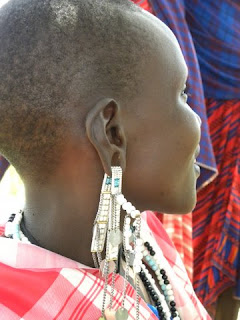No one can come to Tanzania without going on safari. Within two hours by road from Arusha are two incredible parks, where animals roam free within their natural habitat. In Swahili, the word safari means "journey." Although Jason and I are on our own journey here in Tanzania, last week we had the opportunity to take a break from writing and hospital work and join a group of American volunteers on a two-day safari. Seeing such abundant wonders of nature up close reminded me again and again of the phenomenal creation on this earth. How can all of this magnificence be random?
Our first stop was Tarangire National Park--a grassland filled with Baobab trees and all the animals and birds that benefit from them. Animals roam in Tarangire year-round because the area has a permanent river. During the dry season, they migrate to the park for water. The rains have been early and heavy this year, so we are well into the lush, green season.

I never tired of watching the elephants. I wrote my first research paper on elephants in 5th grade! My resource was a 1960 National Geographic that I found at the Akron Public Library. Perhaps I love elephants because they have a matriarchal society. Maybe I'll join them.

My second cousins, baboons, were everywhere. This baby is smart to catch a ride.

Impalas and baboons live well together in the same space.

Giraffes are the most graceful animals I have seen. Did you know that they have 7 vertebrae in their necks just like humans?

The well-kept nests of the weaver birds.

These ostriches were constantly moving--heads up, heads down, shake the backside, repeat!

Jason and I at our picnic lunch spot overlooking the river.
After a night at a pleasant lodge in Karatu, we traveled the Ngorongoro Crater. This 3-million-year-old crater was formed by a volcano. 2000-foot-high walls surround the entire depression, creating a natural enclosure which keeps the migrating herds within. The local Maasai people have maintained their right to graze cattle in the crater, so the park is a conservation area as opposed to a national park. With herds of wildebeest and zebras come many predators such as lions and hyenas. If I were a cattle herder, I would stay far away from here!


Jason and I perched at the rim of the crater.

On the drive in, a friendly roadblock halted traffic. I particularly enjoyed the baboon in the middle of the road picking his belly-button lint. I can relate.

Taking the scenic route down into the crater, we encountered a family of lions on the edge of the road. I wondered if the animals ever came out of the crater and into the surrounding area. This was my answer. Good thing we didn't take a "coffee break" (ie, pit stop) anywhere near these guys!

This lion cub was not impressed by us. I think he had just been fed his breakfast.

The crested crane is on the Ugandan flag. My friend Freda from Uganda had the flag hanging in her apartment in Montreal. Right next to her roommate's home-state flag of Texas. Quite a contrast.

Thompson and Grant gazelles were seen throughout the crater. Flamingos are lining the water's edge in the background.

Zebras are fascinating to watch. Believe it or not, their stripes make them difficult to spot from afar.

Rubbing themselves in the dust helps camouflage them even more. This one reminded us of our dog Nellie--but a striped belly instead of a spotted one!

The crater rim is lined with canopies of Acacia trees.

This was my prize photo of the day--one of two hippos in a fierce battle.

Hmmm.....

And the most incredible creature of them all...the khaki-clothed tourist!


































